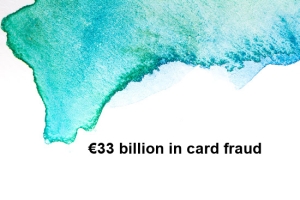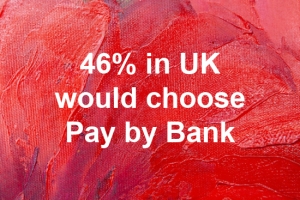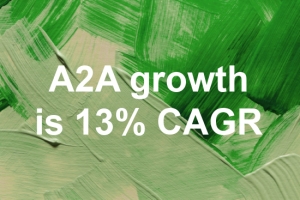By Harald Walden, CTO, Brite Payments
For financial institutions (FIs), the rising threat of fraud makes exploring and adopting more robust fraud detection and prevention strategies more important than ever. Pay by Bank can help to bridge the gap between FIs, businesses and consumers by creating a safer alternative in our increasingly digital economy.

The payments landscape is undergoing a significant transformation, driven by technological advancements and an urgent need to enhance security. As of 2022, global losses from card fraud had soared to $33 billion annually, with projections indicating that this could reach a staggering $40.6 billion by 2027. In Europe alone, card fraud accounted for $4.3 billion in losses in 2022. Despite the deployment of advanced security technologies, the relentless rise in fraudulent activity highlights the limitations of traditional payment methods.
This is where new advancements in payment innovation come into play. Pay by Bank, which increasingly leverages open banking technology, is a fast-growing category of online payments that circumvents many of the issues with card payments. Since these payments are authenticated directly through the consumer’s bank using secure APIs, the risk of fraud is significantly reduced. Pay by Bank enhances security and streamlines the payment process, providing consumers with faster, more convenient transactions.
Understanding the Vulnerabilities of Card Transactions
Traditional card-based transactions are inherently more susceptible to fraud. This vulnerability stems from the reliance on a physical instrument — a bank card — which can be compromised. When a bank card falls into the wrong hands, it becomes alarmingly simple to execute fraudulent transactions. Contactless payments have only escalated this risk, as the limits for transactions without additional authentication (such as a PIN) have gradually risen. While these payments are authorized as long as the cardholder is making the transaction, there is always a balance to strike between minimizing fraud risk and ensuring customer convenience.
Worryingly, fraudsters don’t need to steal physical cards to exploit them. By card skimming, fraudsters can copy the data from a card’s magnetic strip, enabling them to exploit the stolen information. Although the adoption of EMV chip technology has reduced the prevalence of skimming, it remains a concern, particularly in regions where magnetic stripe technology is still in use.

This is despite efforts by major providers like Mastercard to phase out magnetic stripes to combat fraud. In the first half of 2023, the total losses from terminal-related fraud attacks in Europe amounted to €105 million, with €88 million coming from card skimming. Although this is a 40% decrease from the previous year, which shows that enhanced security measures have a positive impact, it remains a significant issue.
Skimming isn’t the only type of fraud that engulfs payments. Identity fraud is also heavily associated with card payments, accounting for 33% of all card fraud in 2023, with one in five Europeans having experienced it. Additionally, phishing attacks targeting cardholders surged by 65% year-over-year, with individuals or groups employing increasingly sophisticated AI-driven methods to achieve their goals. These statistics highlight a growing payment challenge exacerbated by continued reliance on traditional card payments. This emphasizes the need for more secure alternatives, such as Pay by Bank.
The Broader Impact on Consumers and Financial Institutions
The repercussions of financial fraud extend far beyond the immediate loss of money, creating a snowball effect of negative outcomes for merchants, consumers, and FIs. EU financial regulators revealed that in 2023, over €633 million in Europe was lost via fraud using cards. These losses encompass not only the stolen funds and capital but also the out-of-pocket expenses and the significant amount of time required to resolve fraud-related issues.

Adjacent to the direct financial losses, fraud has a profound and often underestimated ripple effect on consumer trust and loyalty. This impact on consumer trust can be seen in a recent survey by Javelin Strategy, which found that 44% of fraud victims considered switching financial institutions after experiencing card fraud, underscoring the critical role of secure payment methods in maintaining customer trust and loyalty. If not addressed, this erosion of trust can lead to customers becoming hesitant to engage with digital payments and banking services, ultimately harming the broader financial ecosystem.
FIs and payment providers are responsible for addressing the immediate financial impacts of fraud to ensure that we can operate in a secure financial environment. Rebuilding trust with consumers after such incidents is imperative, demanding significant efforts to enhance security measures and provide consumers with more choices in their payment methods.
The Rise of Cardless Payment Solutions
As the threat of fraud escalates, cardless solutions, like Pay by Bank, are gaining traction as a safer alternative. These solutions enable direct bank-to-bank transfers without needing a card network or other intermediaries, leveraging open banking APIs to facilitate real-time transactions securely and efficiently.
Pay by Bank neutralizes a wide range of fraudulent activities by eliminating the need for card credentials, which is a primary target for bad actors. Customers who utilize Pay by Bank also benefit from additional and enhanced security features, such as multi-factor authentication (MFA), which provides an extra layer of protection.

This enhanced security is increasingly influencing consumer preferences. Brite Payment’s recent Instant Economy Payment Insights report revealed that 46% of UK respondents would choose Pay by Bank as a payment method due to its higher level of security. By utilizing open banking technology, Pay by Bank offers a more secure payment method thanks to Strong Customer Authentication (SCA), bank-grade encryption and the absence of shared login details.
In addition to providing enhanced security, Pay by Bank payments often come with lower transaction fees than cards and digital wallets (often card payments with a digital interface). This reduction in fees benefits customers by potentially lowering their overall costs and provides merchants with a more cost-effective payment solution. By minimizing transaction costs, both parties can benefit, making Pay by Bank payments an attractive option in an evolving payments landscape.
Future Outlook and Strategic Implementation for Financial Institutions
As consumer perceptions and behaviors around payment alternatives continue to evolve, traditional card payments may face increasing displacement. The growing adoption of Pay by Bank, particularly in regions with robust open banking frameworks like Europe and parts of Asia, suggests a future where secure, cardless transactions become the norm.

The demand for more secure payment options, like Pay by Bank, is on an upward trajectory, with global growth of instant payments expected at a compound annual growth rate of 13% CAGR through 2026, resulting in a global e-commerce market size of nearly $850 billion. As card fraud continues to pose a threat, estimated to cost the global economy $41 Billion in losses, FIs must explore partnerships with fintech providers to seamlessly integrate more secure and efficient payment solutions like Pay by Bank.
By adopting these technologies, banks and FIs can provide their customers with added value, ensuring long-term trust and loyalty. Although seamlessness and user experience are vital, they cannot be prioritized over security. Pay by Bank’s strength in balancing all these aspects positions it as a leading option for the future of digital payments.
About the Author

Harald Walden is the Chief Technology Officer (CTO) at Brite Payments and oversees several key departments, including development, QA, internal IT, cyber security, data/BI, and information security. Harald began his career in the technology industry as a developer, eventually transitioning into various management roles. His broad experience provided the foundation for his later successes. During a five-year tenure at Stardoll, Harald served as Head of Product before moving into the payments industry. He then worked as CTO and Co-founder at Qliro, helping lead the company to grow to 250 employees.
In 2019, Harald joined Brite Payments as CTO. Being one of the original employees, he has played a crucial role in the company’s growth from a small team to more than 150 employees. Harald is not only a key member of the executive management team but also contributes to the strategic decision-making process at Brite. Having worked in the payments industry for over 14 years, Harald’s career is a testament to his technical expertise, leadership qualities, and visionary approach to technology.
Recent PaymentsNEXT news:
Network Tokens: Understanding the Technology Transforming Consumer Payments

